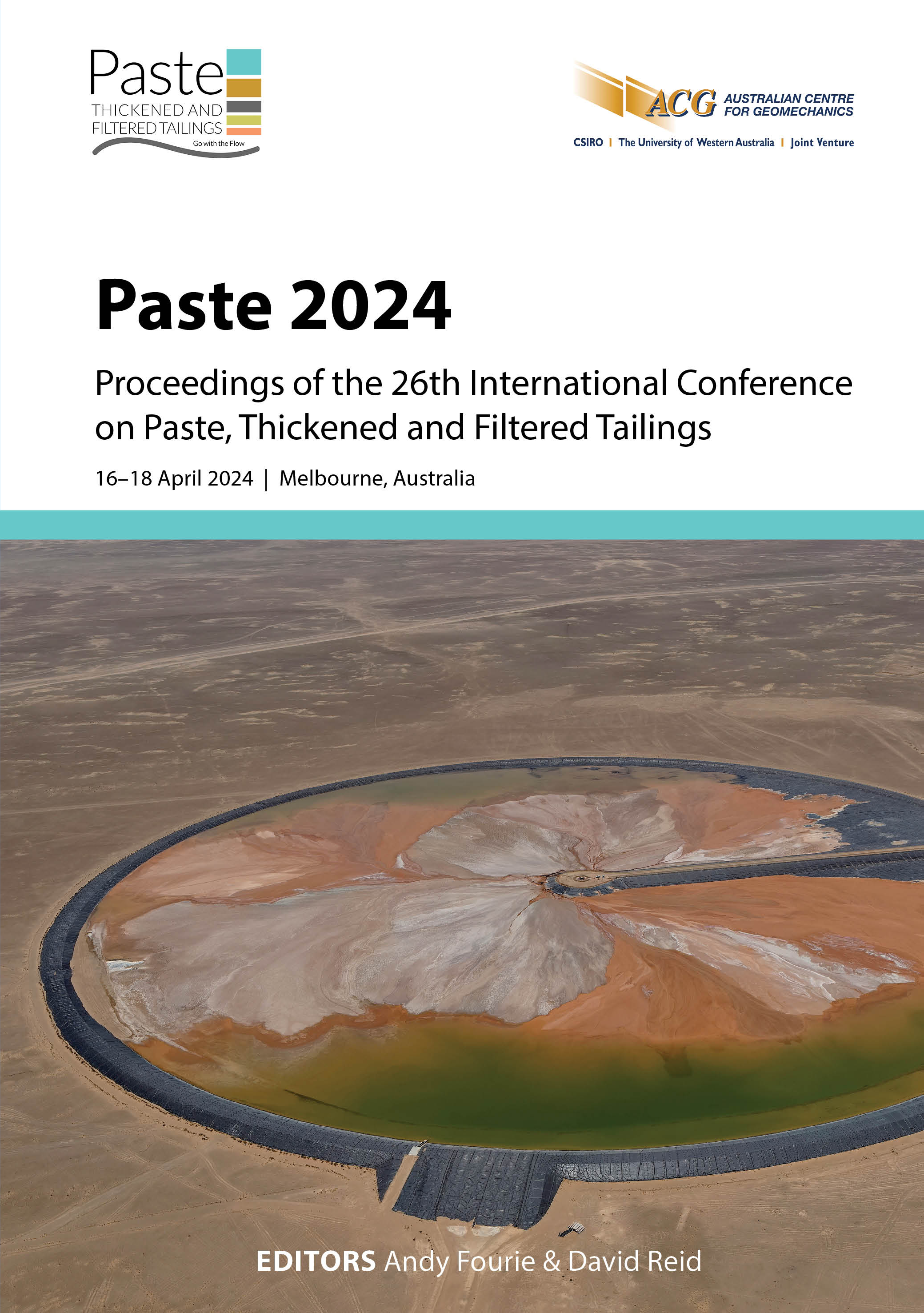Enhancing cemented paste backfill using chemical admixtures to create economic and environmentally sustainable paste fill

|
Authors: Sadler, O; Ricketts, S; Koupriantchik, D |
DOI https://doi.org/10.36487/ACG_repo/2455_32
Cite As:
Sadler, O, Ricketts, S & Koupriantchik, D 2024, 'Enhancing cemented paste backfill using chemical admixtures to create economic and environmentally sustainable paste fill', in AB Fourie & D Reid (eds), Paste 2024: Proceedings of the 26th International Conference on Paste, Thickened and Filtered Tailings, Australian Centre for Geomechanics, Perth, pp. 395-418, https://doi.org/10.36487/ACG_repo/2455_32
Abstract:
Cemented paste backfill (CPB) has emerged as a crucial component in underground mining operations, offering essential support in the underground mine and assisting in tailings disposal. This, in turn, ensures mine safety and sustainability. However, CPB can contribute to a sizeable portion of total mining operational costs, necessitating the exploration of innovative approaches to enhance performance and minimise environmental impact. In response, this study conducted extensive field trials at a Western Australian gold mine, with the aim of optimising CPB mix designs by incorporating the chemical admixture MasterRoc MF 707. The main goals were to increase solids content, reduce binder content, and assess the effects of the admixture on flow properties and early strength development. The field trials followed a systematic approach, starting with laboratory tests that displayed the potential of MasterRoc MF 707 in enhancing CPB rheological properties. Large-scale trials progressed at the operating paste plant in three distinct stages: plug pour, main body pour, and solids increase and binder decrease. At each stage, critical parameters such as yield stress, pipe pressures, mixer torque, and unconfined compressive strength (UCS) of the cured paste were carefully monitored to assess the effectiveness of the chemical admixture. Stage 1 of the field trials focused on the plug pour. The introduction of MasterRoc MF 707 resulted in a significant reduction in yield stress of more than 50% and mixer torque by 9.5%. Moreover, pipe pressures were reduced by 50%. The early strength development was particularly promising, with 100 kPa achieved within 24 hours, leading to more efficient backfilling operations. Further UCS testing revealed that the 7, 14, and 28-day strengths outperformed the control sample by up to 40%. In Stage 2, the main body pour displayed similar positive trends to the plug pour. With a 41.6% reduction in pipe pressures and a 52% decrease in yield stress, this study demonstrates the potential for reducing the amount of binder reduction used while still maintaining operational parameters. UCS testing confirmed a substantial increase in strengths, with the admixture-enhanced designs outperforming the control at various lower binder content levels. Stage 3 aimed to optimise the mix designs further by increasing the solid content and reducing the binder content. Cost analysis demonstrated potential savings in binder costs with the utilisation of admixtures. Furthermore, an assessment of CO2 emissions revealed significant reductions, which contribute to a more environmentally friendly mining practice. Overall, this study presents evidence that the chemical admixture, MasterRoc MF 707, can enhance CPB mix designs, offering multiple benefits such as improved rheological behaviour, increased early strength, cost savings through binder reduction, and reduced environmental impact. By using innovative technologies and practices, the findings show the potential for successfully integrating chemical admixtures to enhance CPB.
Keywords: cemented paste backfill, yield stress reduction, binder reduction, chemical admixture, UCS strength increase, carbon footprint reduction
References:
Once rheological testwork had been completed, the emphasis of the project shifted to assessing the strength development profiles of the various CPB mixes via UCS testing (Standards Australia 2014).
Martic, Z, Gelson, JE, Champa, J & Knight, B 2011, ‘Admixtures in backfill applications for cost and performance benefits’, in R Jewell & AB Fourie (eds), Paste 2011: Proceedings of the 14th International Seminar on Paste and Thickened Tailings, Australian Centre for Geomechanics, Perth, pp. 523–536,
Standards Australia 2014, Methods of Testing Concrete - Compressive Strength Tests - Concrete, Mortar and Grout Specimens (AS 1012.9:2014).
Weatherwax, T, Evans, R & Hafeez, F 2011, ‘The utilization of paste backfill admixtures at Barrick gold mines’, Minefill 2011: Proceedings of the 10th International Symposium on Mining with Backfilll, The Southern African Institute of Mining and Metallurgy, Johannesburg.
© Copyright 2025, Australian Centre for Geomechanics (ACG), The University of Western Australia. All rights reserved.
View copyright/legal information
Please direct any queries or error reports to repository-acg@uwa.edu.au
View copyright/legal information
Please direct any queries or error reports to repository-acg@uwa.edu.au
